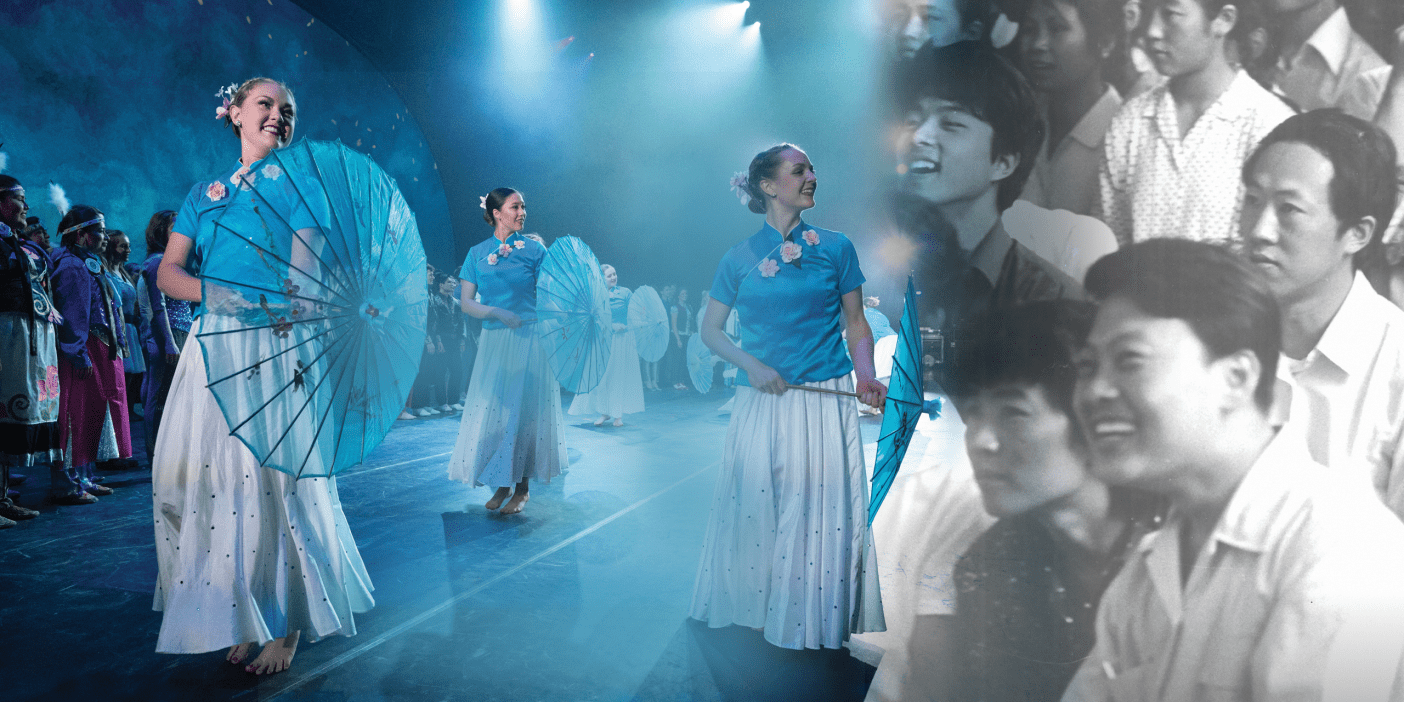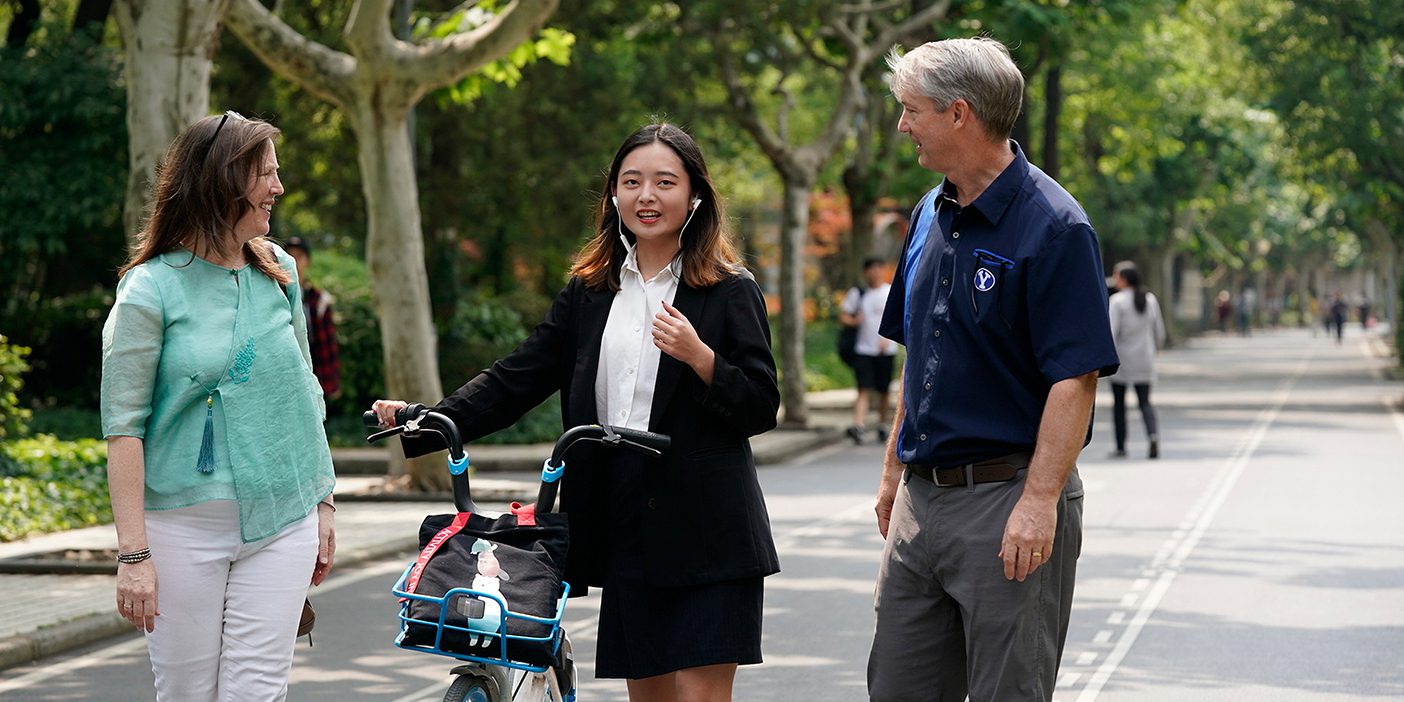Drawing from 21 museums in nine different provinces, an exhibition at BYU’s Museum of Art will provide a rare glimpse into the culture of China.
By Gary S. Williams
On November 1, the “Imperial Tombs of China” exhibition commences at BYU’s Museum of Art. Of all the many cultural manifestations that China could release for public viewing, one might ask why a collection of artifacts from imperial tombs? Why not a display of traditional Chinese paintings, or of porcelain ware, or of objects detailing China’s scientific contributions
to the world?
Besides the fact that there is an abundance of neatly preserved tomb artifacts begging to be exhibited, and that the amount of material is growing with each excavation, the funeral ritual associated with and reflected in the functions of these objects has become recognized as pivotal to our understanding of China’s social, religious, and political patterns, not only of days past, but perhaps of contemporary China as well. Indeed, it has been suggested by several contemporary scholars that, of all China’s rituals, the death ritual may be the most important.
Anthropologist James Watson responds to the question, What has held Chinese society together? by arguing that “to be Chinese is to understand and accept the view that there is a correct way to perform rites associated with the life cycle, the most important being weddings and funerals.”1 This statement becomes meaningful when one realizes that throughout its history China has been made up of heterogenous groups of people, speaking different languages and dialects, some with quite different cultural experiences and institutions. This large body of people was spread over a great expanse of land, and yet China has somehow been held together in a manner never experienced by the countries of Europe, whose peoples seem to be infinitely more juxtaposed.
For many years scholars have proposed that China’s ubiquitous written language, as used for all literary, religious, and historical texts, has cut across the many dialectal differences and thus given China a common written medium. In recent years, however, scholars have begun to more completely appreciate the importance of the role of rituals in binding together the disparate elements of a culture. By adhering to ritual routines, at all levels of society, a nation’s citizenry actively takes part in the process of cultural homogenization. During China’s late imperial period, especially, the rituals connected with marriage and death formed an adhesive that held this wonderfully intricate and diverse society together, thus the relevance today of an exhibition of funerary artifacts.
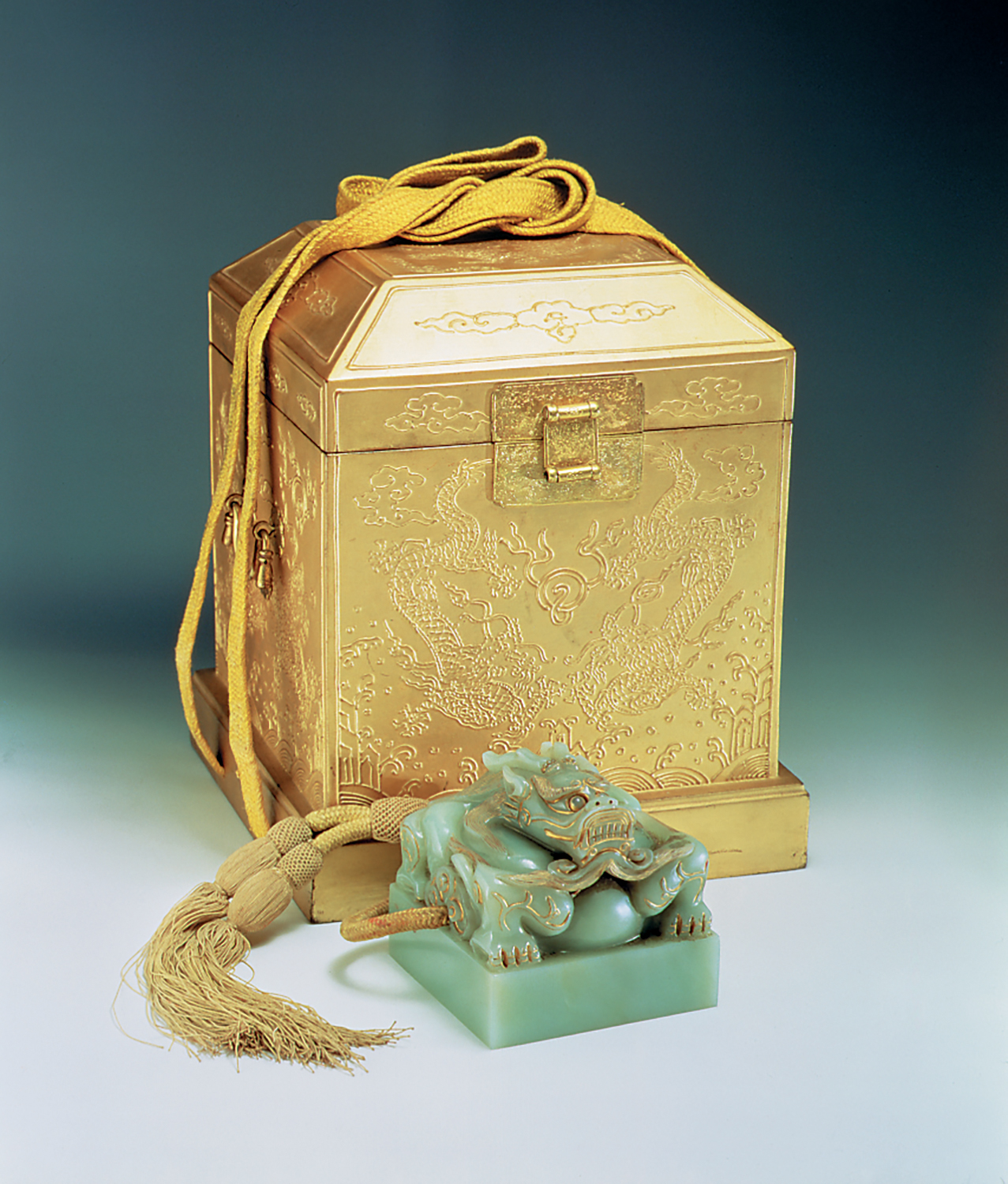
This jade seal (foreground) was made to record the honorific, temple, and posthumous names of the Shunzhi emperor (1643–1661 A.D.). It is shown here with the outer box in which it was stored. Photo by Chan Junghua.
The Ascendant Law of Kinship
A fundamental idea inherent in Chinese funeral rites is that the deceased’s family status remains the same in death as it was in life. In the world of spirits, just as in the world of the living, the law of kinship is ascendant. For males, the kinship relationship through the father’s line does not terminate with death, while the female, having been married into the husband’s family, becomes an integral part of the patrilineal line and receives respect and filial care in her death by virtue of her husband’s lineage.
Another important aspect of the Chinese concept of death is the principle of reciprocity. Throughout one’s young, formative life, an individual will have been blessed in myriad ways by the caring acts of parents. Parents, in the Chinese world, are expected to train and teach, to feed and clothe, and to protect and correct their offspring. In return, maturing and aging parents can expect to be respected and materially supported by their children.
In an ancient Chinese text of somewhat uncertain origin, the following dicta are ascribed to Confucius: “A filial son serves his parents in the following ways: When his parents are simply residing at home, he then carries his respect to the utmost; when they are being nourished, he then offers his joyfulness to the utmost; when they become ill, he then carries his concern for them to the utmost; when they are being mourned for at the time of their death, he then carries his grief to the utmost; and when they are spirits he sacrifices to them with strictest reverence.”2
Clearly, death does not revoke the filial relationship a child has with his parents. Indeed, this relationship is even more heightened and severe in death. Chinese funerals, therefore, are a composite of offerings by which food, money, and a variety of material goods are transmitted to the spirit world for use and consumption by the deceased parent or ancestor. The Chinese believe the dead live in a world that replicates our own and therefore have similar needs and requirements. If these needs are met by the offerings of descendants, then the later can expect material rewards from the spirits.
This provides an interesting advantage to the living over the dead. Emily Ahern, a leading scholar and anthropologist in the field of Chinese studies, writes: “the living hope to inspire a… reciprocal response from the ancestors, to obtain through them the good life as they perceive it; wealth, rice harvests, and offspring.”3
Children in Chinese society have a weighty responsibility in caring for their parents in life and death. A child will always have a debt he owes to his parents for their gift of life and their acts of attentive support and guardianship. A child, when capable of making a contribution to the family, begins to work off the debt through material support of parents and by showing respect to them through filial devotion. But, as stated above, this debt is never completed at the death of a parent; even after their parents’ mortal demise, a child must continue to make appropriate and timely offerings to their spirits.
Needs Beyond the Grave
Ancestor worship—the belief in uninterrupted kinship ties between the living and spirits of the deceased, and the notion that ancestors can intervene and mediate on behalf of the living—was a primary element in the development of the complex and oft-times extravagant and ostentatious funeral rites practiced in China.4 Excavations of tombs of the late Shang Dynasty (1500–1122 B.C.) provide important evidence that the Chinese at this early time carried out luxuriant burial rites. The 1978 excavation of the Fu Hao tomb, in Anyang, Henan, for example, yielded some of the most significant finds for this early period. The grave, a rectangular pit, oriented along a north south axis, contained more than 16,000 bronze, jade, and bone objects and about 7,000 cowry shells (small marine mollusc shells used for money). The mistress of the grave was apparently interred in a coffin, and she was escorted by 16 sacrificial victims (placed above and around the coffin) and six sacrificial dogs.5
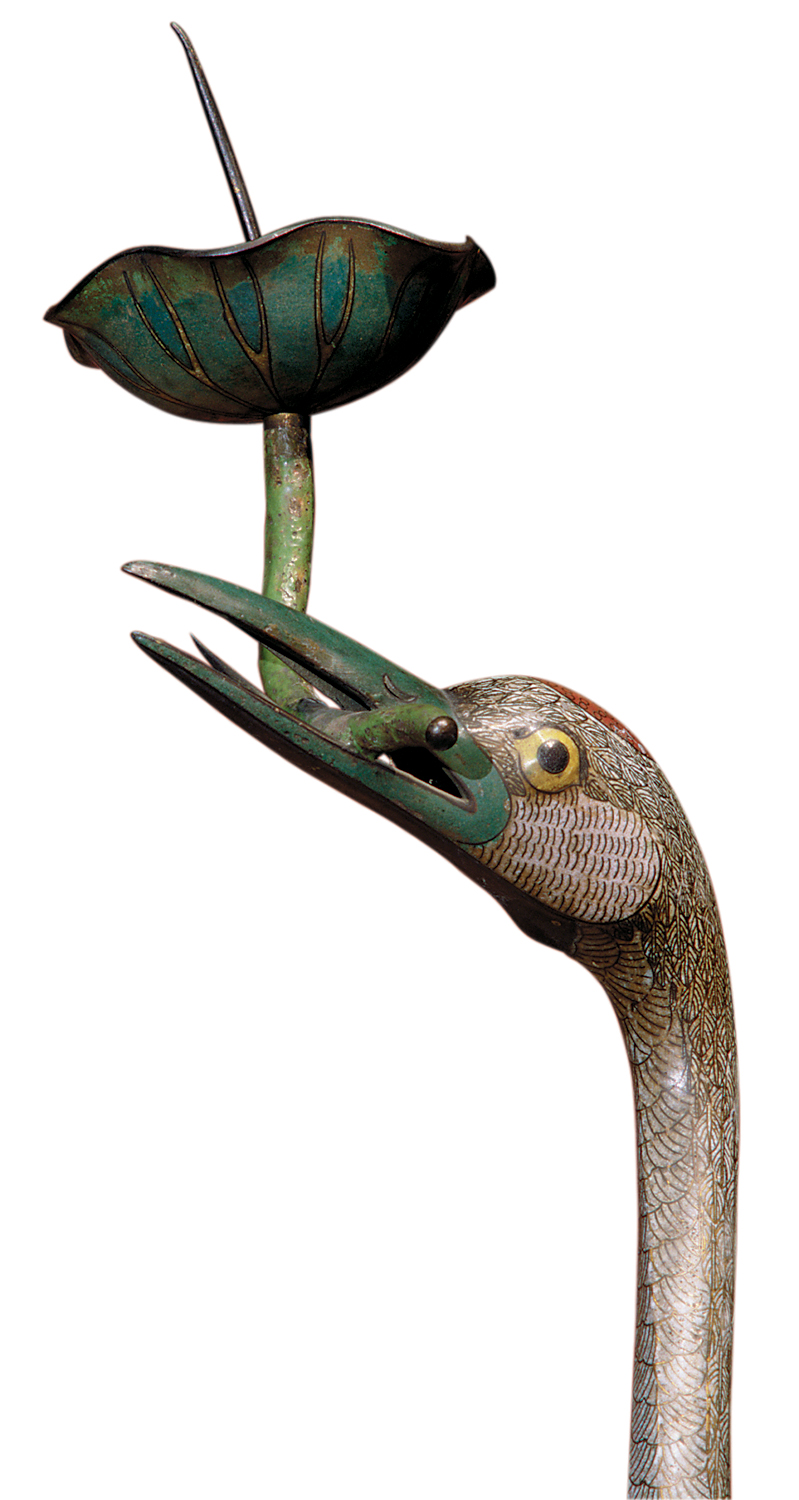
This candleholder, in the form of a crane, symbolized auspiciousness and longevity in ancient China. Photo by John Snyder.
We can infer from these funerary objects that the spirit was expected to continue on with her coterie who would serve her and respond to her needs beyond the grave. This grave site, and others similar to it, is an early example of the strong emphasis placed on the role of ancestor spirits in Chinese culture. The various aspects of funeral rites were, and still are in China, requisite for calming the disembodied spirit and preparing it for its role as ancestor. From early times, it appears, Chinese burial practices and the ancestor worship associated with them were a ubiquitous element in the shaping of Chinese civilization.
Obviously, the Chinese spirit world has its bureaucracy and hierarchy of officials with their entourages of warriors and attendants, living in palatial houses that are, in design, no different from the residences of the living. Chinese literature suggests that court is conducted, social gatherings are convened, and people interact with the most recognizably human flair and idiosyncrasies.
Since the Chinese world of the dead is modeled after the mortal world, Chinese emperors desired to have elaborate tombs that could serve as a post-mortal palace. These elegant and opulent tombs were supplied with objects and utensils to comply with nearly every aspect of existence: musical instruments made of bronze and wood; bronze vessels used for ceremonial washings and for food and wine; clothing and ornately decorated clothing chests, including bronze mirrors, jade belts, and jade belt ornaments; pottery figurines of men and women and soldiers and entertainers; and pottery models of houses with enclosed courtyards. (This listing does not begin to exhaust the collection of objects and materials retrieved from the diggings.) The 4th-century B.C. Confucian thinker Xunzi, in his essay “On the Rules of Proper Behavior,” seems to encapsulate the rationale for such lavish burial preparations and rites: “The funeral rite is the beautification of the dead by the living and the sending off the dead as we sent them off when they were alive, and one serves the absent as though present. Their end and beginning are thus unified.”6
The Evolution of the Tombs
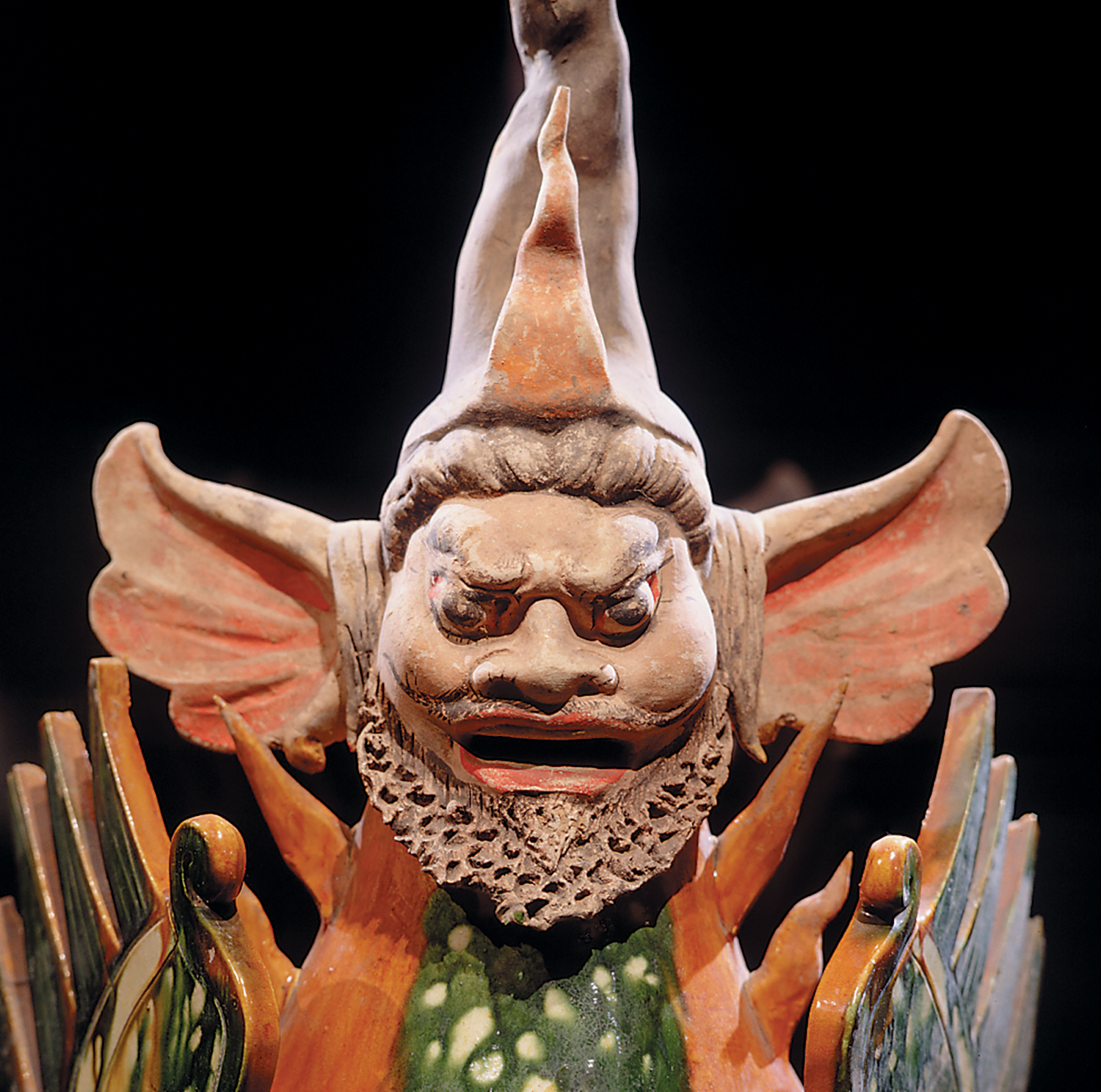
This ceramic figurine, from the Tang dynasty (618 –906 A.D.), was placed in the emperor’s tomb to protect against evil forces and grave robbers. Photo by John Snyder.
Chinese imperial tomb design has changed somewhat over the centuries. Tombs have evolved from simple earthen pits faced with thick wooden planks, to cavities reinforced with stone, and finally to a complex of vaulted rooms made of stone. This series of subterranean vaulted rooms became known as the “dark place” or the “secluded palace,” and has often been referred to as the “under-ground palace.”
The tradition of building an earthen mound on top of a grave began very early, as early, in fact, as the 20th-century B.C. The Fu Hao tomb of Anyang, alluded to above, has foundation traces near the surface of the earth, suggesting that a building may have been erected over the grave. An important Confucian classical text, The Book of Ritual, indicates that the size of the earthen mound which surmounts the grave should reflect the rank achieved in life. Excavations have shown us that tomb mounds increased in size over the early centuries. In fact, the scale and design of royal tombs, to be commensurate with the exalted status of the emperor, were patterned after mountains, in both size and shape. The tomb of King Wuling of Zhao, for example, became known in history as Mount Zhao. During the Tang Dynasty (618–907 A.D.), the practice was to construct the grave chambers in an existing mountain, rather than building a mound of earth over the tomb. This produced an imposing tomb structure truly befitting the lofty status of the emperor. In time, other features were added to imperial tomb sites: Funerary parks were planted and groomed, a “Spirit Road” leading up to the entrance way would be lined with guardian animals and life-size soldiers and officers of the court made of stone; courtyards were enclosed by walls with imposing gateways; and barracks were built to accommodate the caretakers of the tombs. The Ming (1368–1644 A.D.) and Qing (1644–1911 A.D.) dynasties, the last two dynasties of imperial China, constructed tombs that are in many ways a wonderful distillation of ideas characteristic of Chinese tomb architecture. High crenelated brick walls, modelled after Chinese city walls, were built surrounding the tumulus (grave mound). In front of the walled tumulus was a series of buildings, stele towers, and enclosed courtyards planted with trees and gardens similar to what one might see at the residence of a nobleman, except on a grander scale.
The Parents of the Empire
The emperor of China, called the Son of Heaven, stood at the apex of the Chinese social order. He had received the Mandate of Heaven (the right to rule) and was therefore reliant upon two important aspects to be recognized as the certified, legitimate ruler. Having the mandate to govern, he was required to perform the great sacrifices which, when done correctly by the properly attuned and prepared emperor, would harmonize the workings of the universe and thereby enable the country to flourish and be blessed in all its needs. The emperor could also manipulate his role as an heir and a descendant by worshipping his ancestors to firm up his appearance of legitimacy. Both of these official activities were necessary demonstrations for a ruler to be recognized as the rightful recipient of the mandate to rule. The uniqueness of the Chinese emperor was always set off by his performing such seriously eminent duties. But these duties are the extension of the most redoubtable feature in Chinese society—the family.
In Chinese literature, in both historical writings and belle-lettres, the emperor and his empress were traditionally recognized as the parents of the empire and therefore had parental responsibilities toward their populace. The emperor was expected to nurture his people, to secure for them peace throughout the empire, to facilitate education, to provide an environment within which the needed material goods could be acquired, and, perhaps most important, to reflect through his actions a proper model of behavior. An emperor was supposed to be, after all, a compendium of model behavior for all the nation to mimic and recreate.
To be sure, the harmony of cosmic powers could be obtained, not only by the performing of imperial sacrifices, but also by the emperor’s virtuous enactment of familial roles and duties. Kang Xi (1662–1722 A.D.), perhaps the greatest of Qing Dynasty rulers, referred to the indispensability of familial duties in the governing of the empire when he remarked: “We rule the empire with filial piety.” Filial piety, the respect for one’s parents in word and deed and a fraternal duty toward one’s siblings, has long been recognized as the very heart of the Chinese family, which is the very core of Chinese society.
Therefore, when an emperor acted out his familial roles (and this was especially true in his behavior during periods of mourning and in his observances of burial rites), he was providing a pattern of filial piety for his empire to emulate. The implications of these Chinese burial rites could be worked by the grieving new heir to the throne to assert his legitimacy as emperor; he could, through his observance of burial rites, testify to his followers that he was the recipient
of spiritual powers from his ancestors, and he could demonstrate to his populace his mastery of filial behavior. In this, the powers of heaven would coalesce and coordinate for the well-being of the country.
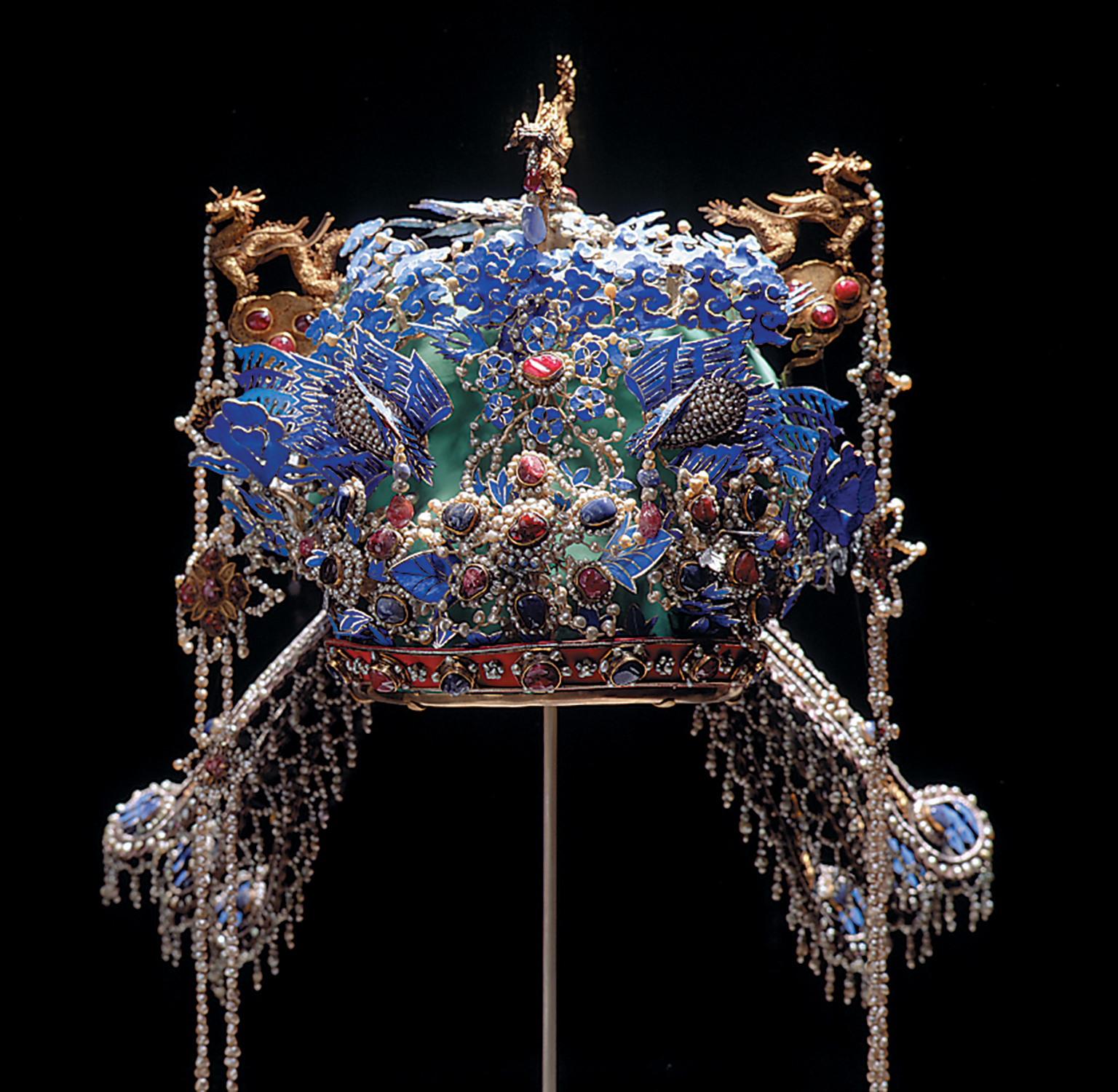
The phoenix crown was part of the ceremonial dress worn by empresses and concubines at their investiture. This crown was worn by the Empress Xiaojing during the Wanli reign (1572–1620 A.D.) of the Ming Dynasty. Photo by John Snyder.
Selecting the Site
A matter with which a new emperor would be pre-occupied was the siting of his tomb. This was a pain-staking process, for the Chinese believed that a tomb site should conform with the landscape and be situated appropriately in relation to bodies of water located nearby. Wondrous fertility, it was believed, could be drawn from the earth and transmitted to the deceased’s descendants. The appropriate siting of a grave, then, would be a decided impetus to the growth and solidification of a dynasty.
Imperial tombs were grand constructions. To construct a tomb required large numbers of workers and excessive sums of money. Qinshihuang, the ruler of the state of Qin from 246 to 210 B.C. who defeated six contending states and unified China, began work on his tomb shortly after his ascension to the throne when he was just 13. Early records inform us (we are never absolutely comfortable with data presented in early Chinese records) that he coerced over 700,000 men to build his tomb. The tomb was reportedly still unfinished 40 years later when the Qin Dynasty collapsed in 206 B.C., four years after his death.
Located on the slopes of Mount Li and to the south of the Wei River, the tomb stands almost 250 feet high and has a circumference of about 1.29 miles. The tomb was originally enclosed by rectangular outer and inner walls, the inner wall 2.4 miles in circumference, and the outer wall about 3.9 miles. Excavations show that the foundations of these walls were 26 feet thick, and that palace-style buildings and pavilions apparently stood within.
The mausoleum has yet to be penetrated and explored by modern-day scientists, but from written records we are provided a glimpse of the alleged richness of its subterranean chambers. Sima Qian, who compiled and wrote his Records of the Historian (Shiji) some 100 years later, records the following with reference to the splendor of the tomb:
[The workers] excavated three springs, and pouring molten bronze they made an outer coYn. Models of palaces, of pavilions and the many offices, rare vessels, precious stones and art objects were transferred to and buried in the tomb thereby filling it up. [Qin] commanded artisans to manufacture mechanical cross-bows so that should there be anyone enter in and draw near to the materials buried there, they would quickly be shot by arrows. They used quicksilver for the rivers and waterways, the Yangzi and Yellow River, and the great sea, and mechanically caused them to flow into each other. On the ceiling of the tomb chamber was inlaid the heavenly constellations, and on the floor was laid out a representation of the regions of the land. They made candles of whale fat, for they estimated that it would be a long time before it would burn out.
The Second Generation Emperor said: “It would not be proper that those among the former Emperor’s concubines who had no sons should come out from this place.” They were all commanded to follow him in death, and those who died were many in number. When the internment was completed someone spoke about the artisans who had made the mechanical devices, that they would know all about what was buried there, and that the significance of the treasure would be forthwith disclosed by them should they be allowed to come out. Therefore, when the great affair was completed and everything was buried away, they closed the main entrance to the tomb and lowered the outer gate, and thus the workmen who had buried the treasure were completely closed in and there was no one who again came out. They planted trees and grass to make it look like a mountain.”7
If this is an accurate description of the tomb’s interior, then the underground chamber is truly consistent with the grand life style maintained by Qinshihuang, as reported in many historical and pseudo-historical records. Less substantial accounts tell of a precious shroud of pearls and jade overlaying the emperor’s corpse, which was clothed in a suit made of pieces of jade sewn together with threads of gold.
The Terra-Cotta Warriors
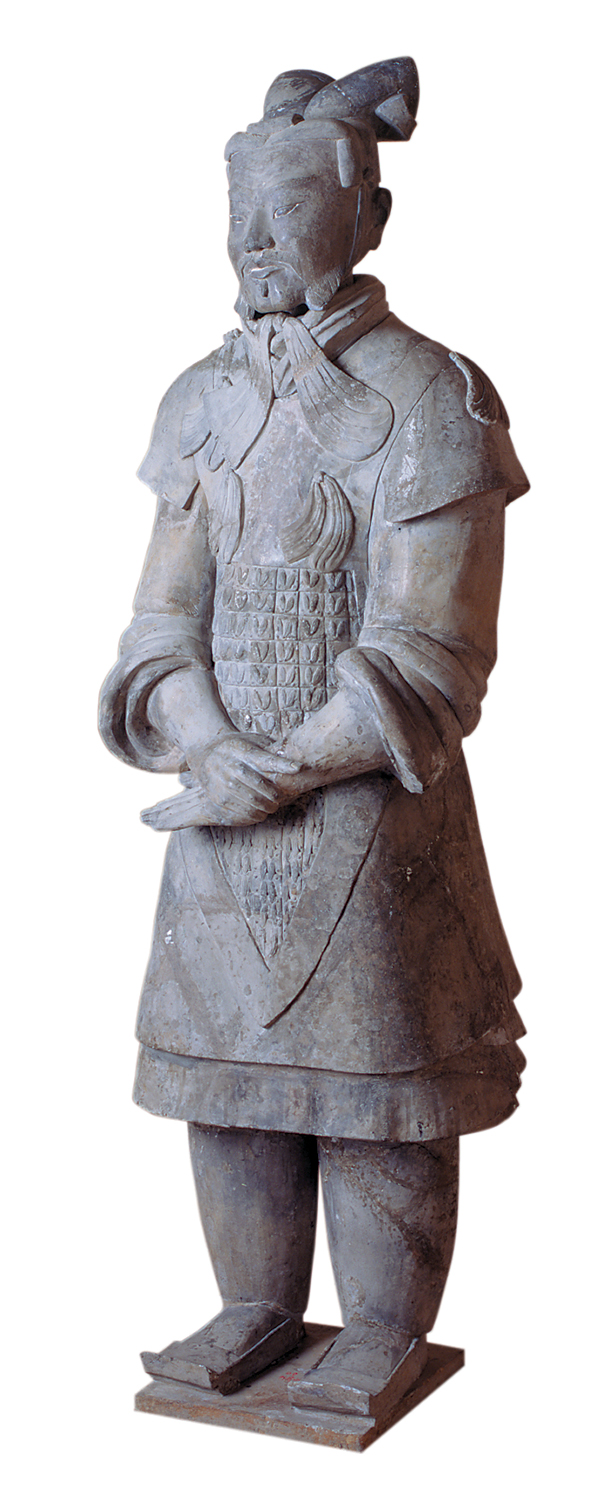
This terra-cotta general, one of thousands crafted during the reign of the First Emperor Qinshihuang (259–210 B.C.), was sculpted to show an attitude of profound contemplation of strategy. This life-sized figure is one of four terra-cotta warriors and a horse that will be exhibited. Photo by John Snyder.
Archaeologists have long wondered if there is more to the imperial mausoleum of Qinshihuang than what is recounted by Sima Qian. In the Zhou Dynasty, for example, members of the aristocracy were buried with a retinue of sculptural figures to accompany and assist them on their way to the world of the dead, while in earlier dynasties real animals and human beings were either ritually sacrificed or buried alive with the deceased. Sima Qian mentions only the workmen and concubines entombed in the grave chambers, but no record is made of an accompanying retinue of officers, soldiers, and attendants to protect and serve the emperor in death. Did Qinshihuang have his coterie of retainers and escorts as found in other tombs?
In March 1974 an answer to this question was at least partially provided when a group of peasants, members of a production team of the Yenhai Commune, made a startling discovery while digging a well. This digging site, only about one mile east of Qinshihuang’s tomb mound, produced fragments of terra-cotta (hard, brownish fired clay) soldiers and horses. These marvelous materials of fired clay were subsequently identified as being from the early Qin Dynasty and are believed to be the remains of Qinshihuang’s army of officers and warriors. Theses figures were modeled on real human sizes and shapes and set in battle formation to protect the emperor and his underground palace, much as his troops were always battle-ready for the protection of his palace during his lifetime.
While there is almost complete similarity in the sculpture of the horses, there is considerable variety of features exhibited among the warriors. The use of diverse head shapes, hair styles, and facial expressions have enabled the artisans to give each warrior his own personality. Some faces appear intense and truculent, some self-possessed and assured, others judicious and shrewd. Eye shapes cover a wide spectrum of configurations, and eyebrows vary widely in thickness, angle and length.
The tumulus of Qinshihuang has yet to be excavated, and scholars can only guess at what might actually be found there. Will the diggers find the interior chambers as Sima Qian described it centuries ago? Could it be even more elaborate and extravagant than it is recorded to be? Scholars anxiously await a decision favorable to the excavating of this famous tomb, their expectations having been heightened by the truly significant contents of the warrior pits nearby.
Excavating the Ding Ling
The Ming Dynasty tomb of the Wan Li emperor is the only imperial tomb to have been scientifically excavated. Zhu Yiyun, the Wan Li emperor (reigned 1572–1620 A.D.), personally selected the site and began its construction when he was only 22. Official accounts inform us that it took six years to complete and at least eight million ounces of silver to fund it. When the tomb was completed, the Chroniclers write, he threw an enormous celebratory party where, 30 years later, he would be buried amid resplendent ceremonies. This tomb, upon his death, was named “Ding Ling,” or “The Royal Tomb of Security.”
The excavation of the Ding Ling is seminal to our understanding of what the interior of an imperial tomb is actually like. Although it is a construction of the late Ming (1500–1644 A.D.), its design may be a reverberation, or likeness, of the imperial tomb pattern throughout Chinese history. J. J. M. de Groot, a sinologist of the last century, advanced such an argument after he completed his research on the surface constructions and designs of royal graves: “The greatest conservatism in matters of religion, ceremonies and rites having dominated the Chinese race through all ages, we are justified in our belief that those sepulchers were built on the same plan which had been transmitted to one another, so that they hold up before our eyes a clear image of the Imperial tombs of every epoch, beginning with the Ts’in (221–206 B.C.) and Han (206 B.C.–220 A.D.). This fact, . . . stamps them as monuments the historical and archaeologic value of which it is hardly possible to overrate.”8
These insightful comments were made nearly a century before the excavation of Wan Li’s Ding Ling. The discoveries of this tomb, made between 1956–1959, strongly underline the claim that similar tomb architecture has continued down through China’s ages. If this is so, we can then expect the pattern of earlier Chinese imperial mausolea to be, in general at least, a variation of the excavated Wan Li tomb.

This long-necked porcelain vase from the Ming dynasty stands 17.3 inches tall and is decorated with mandarin ducks, lotuses, willows, sparrows, and egrets. Photo by Chan Jingua
The Ding Ling of Wan Li is in almost every way similar to the surface design of 12 other Ming imperial tombs constructed throughout an expansive area known as the royal cemetery. The “Spirit Road” leads up to its triple archway entrance which opens on to the first of three large courtyards. Opposite this first entrance way, across the forecourt, is a raised stone platform on which stood another gate leading to the second and larger courtyard. This courtyard, planted with thujas, extends to a massive sacrificial hall platform located in and forming the central portion of the north wall. Although the actual hall, which was made of wood, no longer stands, its stone foundation with raised circular bases on which huge pillars once rested, remains in near perfect condition and suggests the size and significance of that once great edifice.
On the other side of the sacrificial hall platform is the third and largest of the courtyards. Standing preeminently at the far side of this enclosure is the impressive stele pavilion containing a large vertical stone slab on which is inscribed Wan Li’s posthumous title. This pavilion, the tallest structure in the mausoleum’s compound and known as a “Soul Tower,” is built of stone, the upper section of which being beautifully carved and painted in imitation of Chinese wooden architecture. Immediately beyond the Soul Tower is the man-made tumulus, or grave mound, 754 feet in diameter and thickly overgrown with thujas (evergreen shrubs), and encircled by a crenelated city-like wall of about 2,291 feet.
The layout of the Wan Li tomb—its entrance ways, compartments of courtyards and gardens, and circumscribing walls—is an expanded version of the commoners residence, especially as seen in north China. The basic features are the same, with buildings and courtyards similar in shape and orientation, usually north to south, but built on a larger scale. A typical Chinese family compound is characterized by the seclusion it aVords and its neat, well-balanced symmetry. Courtyards are separated by walls preventing people in the outer sections from peering into the inmost areas. The imperial palace, too, is based on this spatial pattern—south wall entrances, a series of enclosed courtyards, and the living residence of emperor and family at the north end. Great privacy was ensured by this design, thereby keeping the emperor’s life effectively obscured from the public’s view (see figures 1, 2, 3). An important idea, already developed above, is strongly reiterated in these corresponding designs: death is simply
a continuation of existence, and the spirits of the deceased must be accommodated in death as when they were living souls. The living quarters of the dead, to be sure, are not dissimilar to the residences of the living.
The burial chamber of the Wan Li tomb, constructed beneath the tumulus, was as impressive as the workers and scholars had hoped it to be. In the fall of 1956, the huge marble doors were located and painstakingly manipulated open. This magnificent subterranean palace, lined with precision-cut stone from ceiling to floor, measures about 286 feet from the entrance way to the wall of the burial chamber at the opposite end. The antechamber and central chamber are each about 24 feet high and 20 feet wide. Nothing was found in the antechamber, but the central chamber yielded three beautifully carved marble thrones, with accompanying glazed pottery ritual pieces, and in front of each cluster of ritual pieces were blue and white vessels of oil, still with wick and oil, perhaps not unlike what we might find when Qinshinhuang’s tomb is finally, if it ever is, excavated.
The real body of precious materials and objects was found in the burial chamber. This chamber, constructed at right angles to the main axis of the tomb, is also vaulted and faced with finely fitted stone. It measures 98 feet long, 32 feet high and 30 feet wide. Here the coffins of the emperor, his empress, and a concubine were placed. 2,648 objects were collected, including jades and ceramics, silk fabrics and clothing, objects made of gold and silver, belts and ornaments of many kinds, bronze and tin funerary utensils, wooden figures and lacquer ware.

These elephants, from the Qianlong era (1735–1795 A.D.), were typically placed near the throne of the emperor and symbolized peace. Photo by Chan Jinghua.
The exquisiteness of these materials may be more than matched by the significant information that these finds have contributed to the study of late imperial Chinese civilization. Weapons for the imperial guards, utensils for daily use, objects of art and materials for writing, and many other items with special functions have given us a more intimate look into China’s past. Professor de Groot did not miss the point when he boldly declared: “The Ming tombs in Ch’ang-p’ing undoubtedly formed one of the largest and most gorgeous royal cemeteries ever laid out by the hand of man. They yield the palm to the Egyptian pyramids in point of bulk, but certainly not in that of style and grandeur.”9
The funerary materials to be displayed at the Imperial Tombs of China exhibition attest to this civilization’s sustained greatness. China is not old, by some comparisons, but no other civilization can boast of such long continuity of government, social structure, art, thought, and religion. This seemingly simplistic statement is not intended to gloss over the many changes that have occurred in China’s institutions, but China has, in spite of many alien and contrary elements, cohesed and carried on through several millennia. Many of China’s institutions have contributed to her cultural identity, but one of the most decisive and influential in the shaping of Chinese culture is the funeral rite.
NOTES
1. James L. Watson, “The Structure of Chinese Funerary Rites: Elementary Forms, Ritual Sequence, and the Primacy of Performance,” in Death Ritual in Late Imperial and Modern China, eds. James L. Watson and Evelyn S. Rawski (Berkeley: University of California Press, 1990), 3.
2. Xiaojing, “Ganying,” 19, in Gujushisan jing, Taipei: Xinxing shuju.
3. Emily Martin Ahern, The Cult of the Dead in a Chinese Village (Stanford: Stanford University Press, 1973), 91.
4. see Evelyn Rawski, “A Historian’s Approach to Chinese Death Ritual,” in Death Ritual in Late Imperial and Modern China, eds. James L. Watson and Evelyn S. Rawski (Berkeley: University of California Press, 1990), 23.
5. see Chang Kwang-chih, Shang Civilization (New Haven: Yale University Press, 1980), 87–89.
6. Xunzi, “Lilun pian”, 246. Xunzi jiju, Shijie shiju.
7. Shiji, juan 6, 292–295, jiwen yinshu guan.
8. J.J.M. de Groot, The Religious System of China: Its Ancient Forms, Evolution, History, and Present Aspect, Manners, Customs and Social Institutions Connected Therewith (1892–1910 ed.; reprint Taipei: Ch’eng-wen, 1969), 1177.
9. Ibid, 1186.
Photo Credits: John Snyder and Chan Jinghua (used with permission of the Memphis International Cultural Series).
Gary S. Williams is an associate professor of Asian and Near Eastern Languages at BYU.
The Emperors’ Tombs Are Opened for BYU Exhibit
With tongue in cheek, BYU’s Museum of Art is describing its upcoming presentation of Chinese funerary artifacts as “the exhibition emperors were dying to get into.”
Between November 1, 1995 and March 16, 1996, visitors to the museum will be able to view nearly 250 artifacts that represent the kinds of artifacts meant to accompany emperors and their courts into the next world—and that span 2,500 years of Chinese culture. Among the brilliant reminders of China’s imperial dynasties are gold, silver, jewels, carved jade, inlaid bronzes, a burial suit of jade tiles linked with gold thread, and a spectacular gem-laden crown. Samples of a vast terra-cotta army that guarded the tomb of China’s first emperor suggest his monumental ambition, while the elaborate throne room of China’s last emperor illustrates the opulence of the palace where the ruler held court.
Two audio tours, an adult version narrated by actor Leonard Nimoy and a whimsical children’s tape featuring the ghost of an ancient emperor who describes his life, will enhance the museum experience. Also offered will be a series of lectures, dance and music presentations, a museum cafe specializing in Chinese cuisine, and an expansive Chinese gift shop.
“There is no practical way for the exhibition to be seen in China,” explains James A. Mason, founding director of the Museum of Art. “To behold these rare cultural relics we’re bringing to BYU, you would have to visit 21 different museums and cultural centers in nine different provinces. I feel confident in saying that this exhibit is a once-in-a-lifetime opportunity to learn about the oldest continuous civilization on earth.”
“Ancient China sought to create underground worlds where death approximates life,” adds Virgie Day, the BYU museum’s associate director. “Their emperors’ tombs rivaled—and sometimes surpassed—their rulers’ sumptuous palaces.”
“What initially impressed me is the size the artifacts we will be displaying,” says Paul Anderson, who is designing the exhibition for BYU. “Items that in a catalogue appear desk-size are actually several feet tall and items that look impressive—such as a pair of stone lions—are massive.”
Advance tickets for the Imperial Tombs of China exhibit are now available. Tickets prices are $10 for adults; $8 for seniors, faculty, students, and staff with identification; $5 for youth 5-18; $30 for families; and $18 for season passes. Organized educational youth groups are admitted for $3.50 per person, and groups of 20 or more may purchase tickets for $8 each. For tickets call (801) 378-BYU1 or 1-800-322-BYU1. Free or reduced admissions are available to those who have membership with the Museum of Art. For additional information, please call (801) 378-8250.
—Charlene R. Winters









